Battle of Mesothene
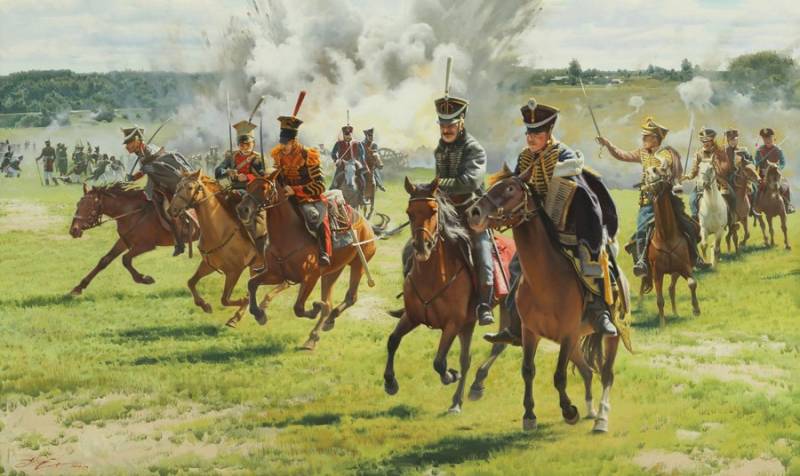
A. Sytov. A squadron of flying hussars
In September 1812, Russian troops under the command of Steingel and Essen tried to defeat the Prussian corps in the direction of Riga. The offensive failed, our troops returned to Riga.
On the Riga direction
8 (20) July 1812 Prussian troops (Battle of Ekau) occupied Mitava. On July 22, at the direction of Napoleon, a department for Courland was created. During the occupation, the territory was thoroughly devastated, bread, horses, cloth, sheepskin coats for the army were taken out, and a 15 million monetary contribution was imposed. Courland was also robbed by various chiefs, deserters from the Great Army.
On July 16 (July 28), 1812, the commander of the Prussian corps demanded the surrender of Riga. General Essen refused. Prussian troops were stationed along the river. Misa, pushing advanced posts to the left side of the Dvina. Detachments of foragers were sent to the right bank. From Riga, detachments came out against them, which were accompanied by local hunters (as volunteers were then called). Essen did not dare to sortie against the enemy. It was justified by the fact that his corps consisted mainly of inexperienced, reserve and reserve battalions and squadrons. This irritated Petersburg.
On July 20 (August 1) 67 gunboats came from Sveaborg to Riga. They went up the river several times to Schlok and above, skirmishing with the Prussians, but without much result. As a result, the end of July and the whole of August passed in inactivity. The military governor of Riga did not dare to take serious actions, in Riga they hoped for the Wittgenstein corps, which successfully fought with the corps of Oudinot and Saint-Cyr. Marshal MacDonald did not have enough strength to begin a full-fledged siege of a large city.
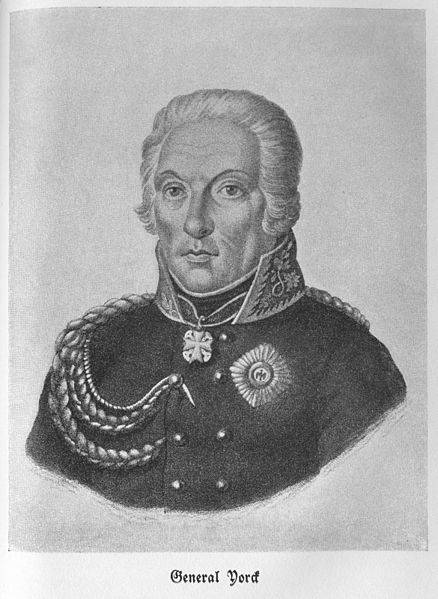
Commander of the Prussian Auxiliary Corps Lieutenant General Ludwig Yorck von Wartenburg
Treaty of Abo
To successfully resist Napoleon, it was necessary to solve the Swedish question. The performance of Sweden on the side of France could sharply worsen Russia's position in the northwestern strategic direction. Russian-Swedish relations at the beginning of the 1807th century were complicated. On the one hand, the Swedes remembered the defeats and territorial losses of the 1808th century. There was a revenge party. On the other hand, the Russians and the Swedes, as allies, fought with France. In 1809, after the conclusion of the Tilsit peace with France, Russia began a successful war with Sweden, which remained on the side of England. In the war of XNUMX–XNUMX Sweden was defeated, and Finland was annexed to the Russian Empire.
Against the backdrop of the defeat, the Swedish king Gustavus Adolf V was overthrown, and the Swedish Riksdag elected Marshal Bernadotte as heir to the throne. Sweden abandoned the alliance with England and began to lay claim to Danish Norway. Russia promised support in this matter.
With the approach of a new Russian-French war, Sweden leaned in favor of Russia. Sweden suffered greatly from the continental blockade of England, the British were its main trading partners (like Russia). In response, Napoleon ordered the occupation of Swedish Pomerania in Germany. This brought Sweden and Russia even closer. On April 5, the Petersburg Union Treaty was signed, according to which Stockholm recognized Finland as Russia, and promised to mediate in Russian-Turkish negotiations. In turn, St. Petersburg promised to support Sweden in joining Norway. The two powers entered into a military alliance directed against France. They even developed a plan for a joint landing in Germany (Pomeranian project).
After the appointment of Kutuzov as commander-in-chief of the Russian army - on August 8 (20), 1812, the Russian sovereign Alexander I went to Abo to meet with the Crown Prince of Sweden. On August 12, the emperor was in Abo, on the 15th, Crown Prince Karl-Johan (Bernadotte) arrived. Bernadotte offered to put up a 30th corps to help Russia. In exchange for Finland. Alexander refused such a deal. The idea of a possible joint landing in the northwestern part of France was also discussed.
On August 18 (30) the Treaty of Abo was concluded. Stockholm finally abandoned Finland and the Åland Islands. Russia promised to put up a 35-strong auxiliary corps to station it in southern Sweden while the Swedish army was busy in the war with Denmark. Alexander agreed to annex the Danish island of Zeeland to Sweden. Bernadotte agreed to the annexation of part of the Duchy of Warsaw to the Russian Empire. Petersburg provided Sweden with a loan of 1,5 million rubles. Both sides invited England to join the alliance.
Thus, Russia got a free hand in the northwest, without fear of Sweden, which could take advantage of Napoleon's invasion to recapture Finland. Petersburg, in turn, strengthened the rights of the new Swedish Bernadotte dynasty.
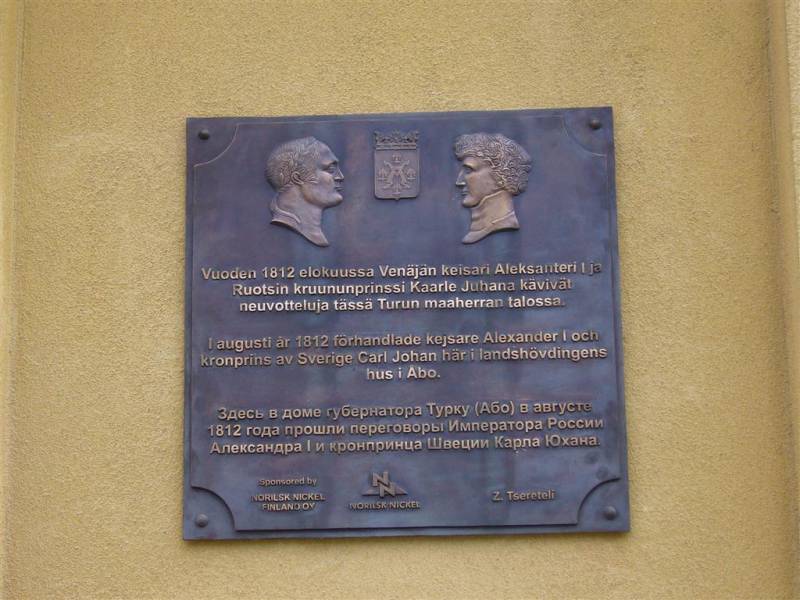
Memorial plaque in Turku (Abo)
Finnish Corps
Joint actions against Denmark were postponed (it was necessary to agree with London and prepare Swedish and Russian troops, the war with Napoleon continued), so Russia got the opportunity to use the troops intended to support Sweden. It was decided to send the Finnish Corps under the command of the Finnish Governor-General Faddey Fedorovich Shteingel to strengthen the garrison of Riga. The general was fighting: he fought with the French in 1807, was wounded, fought twice with the Swedes.
The Finnish Corps was created in the autumn of 1810 from the troops stationed in Finland. In the spring and summer of 1812, he was partially transferred to the Aland Islands for the planned landing, together with the Swedes, in Pomerania on the coast of the Baltic Sea. The corps included: the 6th and 21st Infantry Divisions, the Finnish Dragoon Regiment and the Don Cossack Loshchilin Regiment. In total, by the end of July 1812 - 21 thousand soldiers. On August 18 (30), it was ordered to send a corps from Helsingfors, Alands and Abo near Riga to strengthen the garrison there. Alexander I instructed the Governor-General of Riga to push back the enemy from Riga and Mitava.
Due to the impossibility of approaching Riga due to shallow water, the corps landed on August 28 in Revel. The bad weather damaged part of the ships, some returned to Sveaborg, the departure of others was delayed. The Finnish Governor-General did not wait and set out with the available forces - 10 thousand people. On September 8 (20) the vanguard was at Riga. On September 10 (22), Steingel's corps approached Riga.
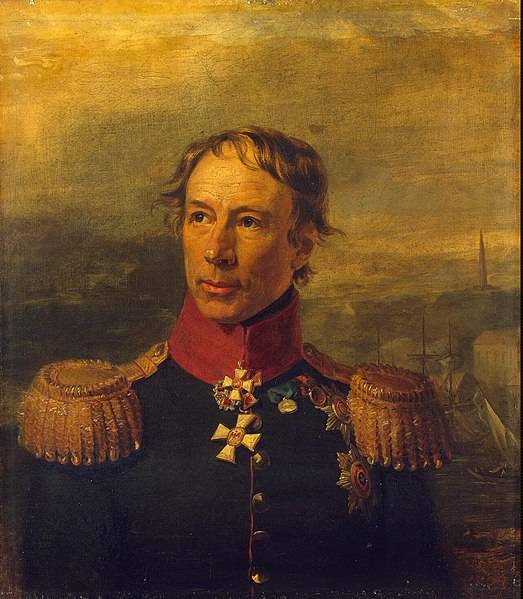
Portrait of the Finnish Governor-General Faddey Fyodorovich Shteingel by George Doe. Military gallery of the Winter Palace
Preparation offensive
There was a lull in the direction of Riga. MacDonald's corps watched Riga without taking active steps, as it did not have sufficient forces and means for a successful siege and assault. In addition, the Prussians were slow to fight in the name of Napoleon and never attacked first. The Prussian general Ludwig Yorck, who succeeded Gravert, tried not to offend the Russians.
Prussian troops were stationed at Mitava. Back in May, siege artillery (130 guns) was sent from Danzig, which arrived in Tilsit in early August and was brought to Ruental near Bauska at the end of August. But the marshal did not have time to start the siege, as Napoleon's order arrived to wait. The French emperor at that time was going to Moscow and believed that peace with Alexander would soon be signed. Therefore, the siege of Riga could not be rushed.
On the other hand, Essen considered himself too weak for decisive sorties. Only sometimes our patrols disturbed the enemy. The arrival of Count Steingel's Finnish Corps was supposed to change the balance of power in our favor. Sending the Finnish corps to Riga, Alexander I set the task of lifting the siege from the city. But having arrived in St. Petersburg, Alexander set Count Steingel a more ambitious task: the two corps of Riga and Finland, which together should have numbered up to 35–40 thousand bayonets and cavalry, were not only to defeat the enemy at Riga, but also to knock him out of the Neman, and go to Vilna. Here to watch the Prussians over the Neman and wait for the arrival of other armies to the Berezina.
However, Essen and Steingel could not fulfill such a task. Firstly, the generals did not have the makings of Suvorov. Secondly, the generals began to argue about the primacy and priority of goals. Thirdly, there were fewer troops than planned. It was believed that Riga could put up 20 thousand soldiers, and Count Steingel - 15 thousand. Essen left 5 thousand to protect the fortress and was able to give General Leviz 10 thousand. The Finnish Corps lost 5 thousand on the road due to the storm. As a result, they could attack no more than 21 thousand people. That is, there was no superiority over the enemy.
Battles near Ekau, Bauska and Mitava
At the military council, Essen, Steingel and Leviz decided to attack the 16-strong Prussian corps of York, which was stationed in the Mitava-Olay region. On September 14 (26), 1812, the offensive began. On the right, coastal flank acted flotilla Rear Admiral Moller, she was supported by a 2-strong detachment of General Brisemann, who was supposed to go behind the lines of the Prussians in the Mitava region. A 1-strong detachment of Colonel Rosen acted against Olai. The main forces of the Finnish Corps and the garrison of Riga - more than 19 thousand with 23 guns, marched along the Bauska road.
Steingel's troops overturned the advance detachments of the Prussians. Upon learning of the enemy's advance, General York began to assemble a corps at Ekau, covering the siege park in Ruenthal. On September 15 (27), around noon, Steingel's corps attacked York's troops at Ekau. After a short skirmish, the Prussians withdrew across the Ekau River and held tight there. The Russians began to outflank the enemy, and the Prussian troops retreated across the Aa River, standing between Bausk and Ruenthal, protecting their siege artillery.
Count Steingel occupied Ekau, the vanguard was in Bauska. Unfortunately, the Russian commanders did not use a good start to quickly develop the offensive. Use the moment while the numerical superiority was on our side. Steingel weakened himself by sending 3 soldiers to Mitava for joint operations with Brisemann and Rosen's detachments. Meanwhile, the enemy, on the contrary, concentrated forces. York decided to temporarily surrender Mitava and ordered the Kleist garrison there to follow him. As a result, the Prussian corps became stronger than the Finnish corps. To save the siege park, the Prussians decided to launch a counteroffensive at Mezoten.
Having learned about the movement of the enemy at Mesoten, Steingel left the Bauska road and turned to the right, also towards Mesoten. At night, the vanguard crossed the Aa River in order to hit the enemy’s left flank. In the dark and when crossing the river, our troops lost order, this allowed the Prussians of Kleist to withstand the attack. After receiving reinforcements from Yorck, Kleist attacked himself. Our vanguard retreated.
Steingel, in conditions when it became clear that the enemy had an advantage in strength, especially in cavalry and horse artillery, did not dare to continue the offensive and withdrew the army to Riga.
York immediately took advantage of the mistakes of the Russian command, at dawn on September 18 (30) went on the counteroffensive and attacked our rearguard. While the rear guard held back the Prussians, Steingel's corps retreated to Olai, where he joined up with the detachments of Briseman and Rosen. Mitava, which our troops occupied for two days, was abandoned again. In the city, materials prepared for the construction of a bridge across the Dvina were destroyed, 4 guns and various supplies were captured. Russian losses in this unsuccessful campaign - about 2,5 thousand people, Prussian - 1 thousand.
On September 20 (October 1), 1812, Russian troops returned to Riga. The failure made a great impression on the townspeople. Came at the same time news about the capture of Moscow by the enemy.
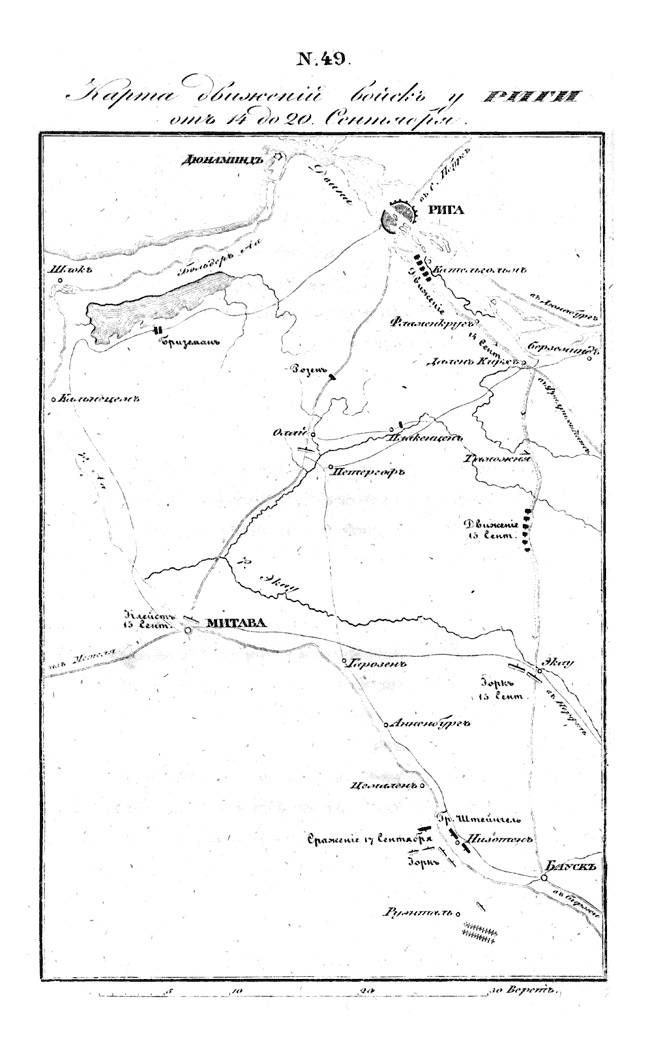
Map source: A. I. Mikhailovsky-Danilevsky. Description of the Patriotic War of 1812, St. Petersburg, 1843
Macdonald's retreat
Not wanting to sit in Riga, Steingel asked permission to transfer the Finnish Corps to help Wittgenstein's 1st Corps in the Polotsk direction. As a result, on September 23 (October 4), Steingel's 10th corps set out from Riga. In Riga and Dunamünde, the former garrison remained - 17 thousand soldiers. On October 17 (29), General Philipp Paulucci replaced General Essen as the Riga military governor and commander of a separate corps.
MacDonald, having learned about the advance of the Russian troops near Riga, moved his forces to help York, leaving one regiment at Dunaburg. Seeing that there was no longer any danger, he returned the French division to Dunaburg. As a result, the French division of Grandjean was inactive throughout the campaign, it was not used in the Riga or Polotsk direction. The siege park was sent back, finally abandoning the plans for the siege of Riga.
Until the late autumn of 1812, both sides were again inactive. Saint-Cyr offered MacDonald to send him 12 men to Polotsk in order to launch an offensive against Wittgenstein. MacDonald replied that he could not allocate more than 4-5 thousand soldiers, since he had to defend a large area, and if it was weakened, a new attack by the Riga Corps was possible. Saint-Cyr replied that 5 thousand was not enough for an attack on the Russians.
MacDonald was the last to retreat from Russia. Until December 5 (17), 1812, his troops stood in their previous positions. He did not receive any instructions from Napoleon's headquarters, which was due to the general confusion that reigned in the Grand Army during its flight from Russia. Macdonald waited for the order, rejecting all the rumors that reached Vilna and Mitava about the defeat and retreat of the French army. Only on December 6 (18) did Murat order the 10th Corps to withdraw. On December 7, MacDonald ordered the withdrawal of the corps towards Tilsit. On December 8 (20), the Prussians left Mitava.
Commander-in-Chief Kutuzov ordered Wittgenstein's corps to go to the Russians (now Raseiniai) to intercept MacDonald. At the forefront were the detachments of Adjutant General Kutuzov and Major General Dibich. For the Prussians, Paulucci's troops also left Riga. The main Russian forces advanced slowly, so they failed to defeat MacDonald. The French marshal suspected the danger that threatened him, accelerated the march, and on December 15 (27) defeated Vlastov's detachment, the former vanguard of Kutuzov, who was already in Tilsit. Kutuzov, not considering it possible to stop an entire enemy corps, cleared the way for the enemy to Tilsit. MacDonald stopped at Tilsit, waiting for York's rear columns.
Meanwhile, the Dibich detachment, marching on Memel, cut off the road to the Prussian troops. There were only 1 Russians and the Prussians (400-14 thousand) could overturn them. However, the Prussian generals Kleist and Yorck did not want to fight the Russians. York, at his own peril and risk, concluded the Taurogen Convention with the Russians on December 16 (18), according to which his corps began to adhere to "neutrality". This agreement was the beginning of the transition of Prussia to the side of Russia and the anti-French coalition.
The Prussian troops who were in Tilsit with MacDonald, having received news of York's agreement with the Russians, left the French and went to join their corps. MacDonald had about 5 thousand soldiers left, and on December 19 he hastily retreated from Tilsit to Königsberg. The cities of East Prussia and the Duchy of Warsaw, one after another, were occupied by Russian troops. The remnants of Napoleon's army fled to the Vistula.
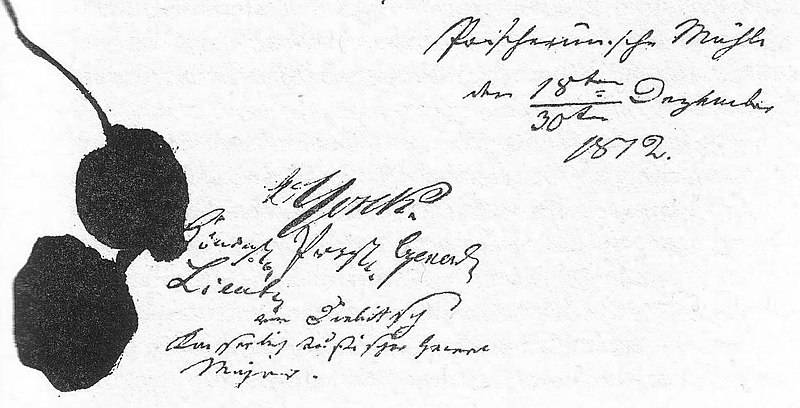
Taurogen Convention signed by General York
Information